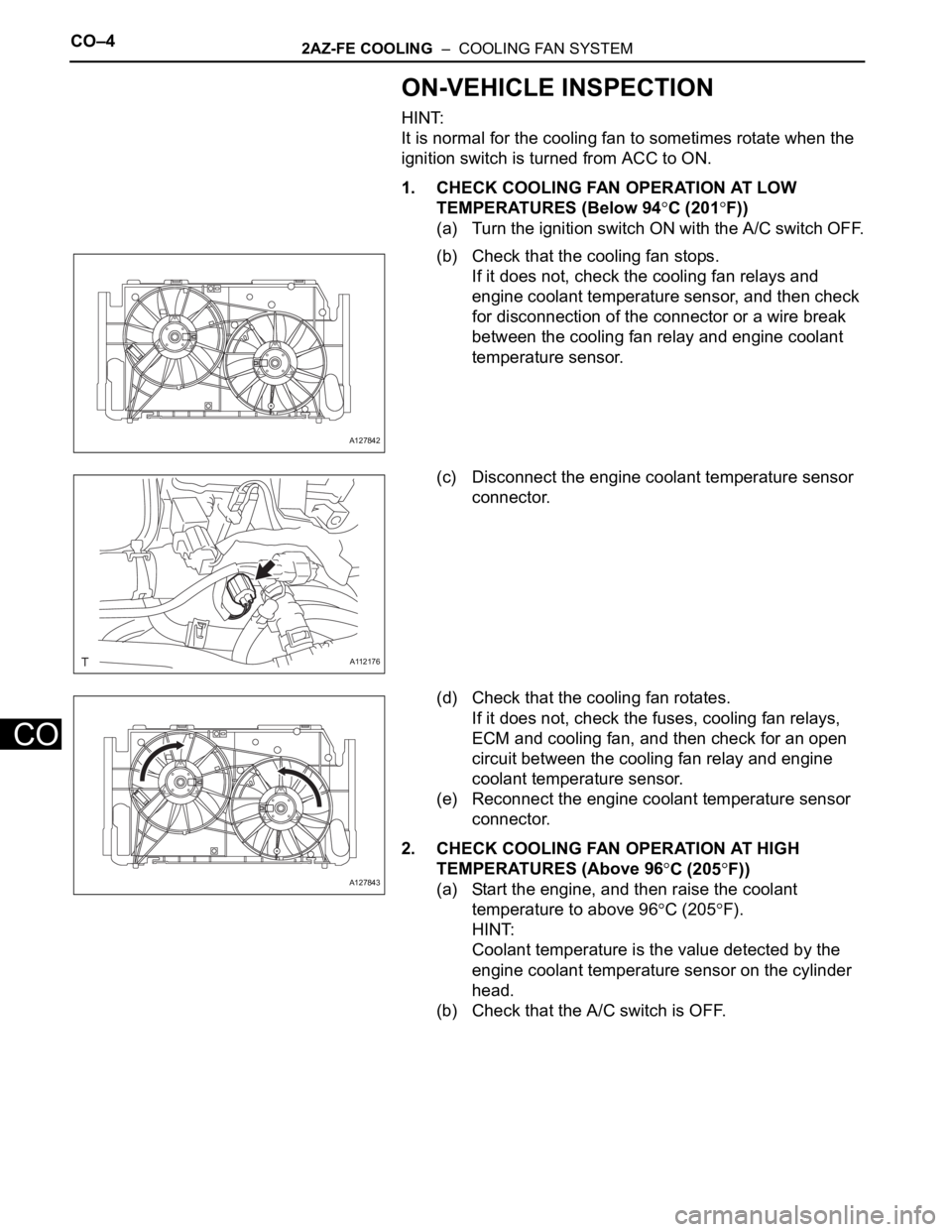2006 TOYOTA RAV4 coolant temperature
[x] Cancel search: coolant temperaturePage 113 of 2000

ENGINE - 2GR-FE ENGINE
238EG70
Synchronous Injection
IgnitionNon-synchronous Injection
Crankshaft Angle # 1
# 2
# 3
# 4
# 5
# 6
0
120240360480600720
Independent InjectionEG-117
Air-fuel Ratio Sensor and Heated Oxygen Sensor
The planar type air-fuel ratio sensor and the cup type heated oxygen sensor are used. For details, see page
EG-37.
6. SFI (Sequential Multiport Fuel Injection) System
An L-type SFI system directly detects the intake air mass with a hot wire type mass air flow meter.
An independent injection system (in which fuel is injected once into each cylinder for each two revolution
of the crankshaft) is used.
There are two (synchronous and non-synchronous) injections:
a) The synchronous injection in which corrections based on the signals from the sensors are added to the
basic injection time so that injection occurs always at the same position.
b) The non-synchronous injection in which injection is effected by detecting the requests from the signals
of the sensors regardless of the crankshaft angle.
Furthermore, to protect the engine and achieve lower fuel consumption, the system uses a fuel cutoff in
which the injection of fuel is stopped temporarily in accordance with the driving conditions.
This system performs group injection when the engine coolant temperature is extremely low and the
engine is operating at a low speed.
7. ESA (Electronic Spark Advance) System
This system selects the optimal ignition timing in accordance with the signals received from the sensors and
sends the (IGT) ignition signal to the igniter.
Page 116 of 2000

ENGINE - 2GR-FE ENGINE
285EG57
Exhaust Camshaft Timing OCV* (Bank 1)
Intake Camshaft Timing OCV* (Bank 1)
Exhaust VVT Sensor (Bank 1)
Engine Coolant Temperature Sensor
Intake Camshaft
Timing OCV* (Bank 2)
Exhaust VVT
Sensor (Bank 2)
Exhaust Camshaft
Timing OCV*
(Bank 2)
Intake VVT Sensor (Bank 2)
Crankshaft Position Sensor
Intake VVT Sensor (Bank 1)ECM
Mass Air Flow MeterThrottle Position Sensor
221EG16
Crankshaft Position Sensor
Mass Air Flow Meter
Throttle Position Sensor
Engine Coolant Temp. Sensor
Intake and Exhaust VVT Sensors
Vehicle Speed SignalECM
Ta r g e t Va l v e Ti m i n g
Feedback
Correction
Actual Valve Timing
Duty-cycle
Control
Camshaft Timing
Oil Control Valve
EG-120
9. Dual VVT-i (Variable Valve Timing-intelligent) System
General
The Dual VVT-i system is designed to control the intake and exhaust camshafts within a range of 40
and 35 respectively (of Crankshaft Angle) to provide valve timing that is optimally suited to the engine
condition. This improves torque in all the speed ranges as well as increasing fuel economy, and reducing
exhaust emissions.
*: Oil Control Valve
Using the engine speed signal, vehicle speed signal, and the signals from mass air flow meter, throttle
position sensor and engine coolant temperature sensor, the ECM calculates optimal valve timing for each
driving condition and controls the camshaft timing oil control valve. In addition, the ECM uses signals
from the camshaft position sensor and the crankshaft position sensor to detect the actual valve timing,
thus providing feedback control to achieve the target valve timing.
Page 125 of 2000

ENGINE - 2GR-FE ENGINE
01MEG21Y
01MEG22Y
Engine Coolant Temperature
Sensor
Crankshaft Position Sensor
Combination Meter
Vehicle Speed SignalECM
CAN
Air Conditioning ECUCooling
Fan
ECUFan Motor
No. 1
Fan Motor
No. 2
Except Towing Package Models
Towing Package Models Engine Coolant Temperature
Sensor
Crankshaft Position Sensor
Combination Meter
Vehicle Speed SignalECM
CAN
Air Conditioning ECUCooling
Fan
ECU
No. 1
Cooling
Fan
ECU
No. 2Fan Motor
No. 1
Fan Motor
No. 2EG-129
12. Cooling Fan Control System
General
A cooling fan control system is used. To achieve an optimal fan speed in accordance with the engine coolant
temperature, vehicle speed, engine speed, and air conditioning operating conditions, the ECM calculates
the proper fan speed and sends the signals to the front controller. By receiving the signals from the ECM,
the front controller sends proper fan speed control signals to the cooling fan ECU.
Upon receiving the signals from the front controller, the cooling fan ECU actuates the fan motors.
Wiring Diagram
Page 126 of 2000

ENGINE - 2GR-FE ENGINE
189EG14 189EG13
189EG16 189EG15
Fan
Speed
Engine Coolant TemperatureFan
Speed
Refrigerant Pressure
Fan
Speed
Engine SpeedFan
Speed
Vehicle Speed (A) Fan speed required by
engine coolant temperature(B) Fan speed required by
air conditioning
refrigerant pressure
(C) Fan speed required by
engine speed(D) Fan speed required by
vehicle speed EG-130
Operation
As illustrated below, the ECM determines the required fan speed by selecting the fastest fan speed from
among the following:
(A) Fan speed required by the engine coolant temperature
(B) Fan speed required by the air conditioning refrigerant pressure
(C) Fan speed required by the engine speed
(D) Fan speed required by the vehicle speed
Page 129 of 2000

ENGINE - 2GR-FE ENGINEEG-133
15. Fail-safe
When the ECM detects a malfunction, the ECM stops or controls the engine according to the date already
stored in the memory.
Fail-safe Chart
DTC No.Fail-safe OperationFail-safe Deactivation Conditions
P0031, P0032,
P0051, P0052ECM turns off air-fuel ratio sensor heater.Ignition switch OFF.
P0037, P0038,
P0057, P0058ECM turns off heated oxygen sensor heater.Ignition switch OFF.
P0100, P0102,
P0103Ignition timing is calculated from engine speed
and throttle angle.“Pass” condition detected.
P0110, P0112,
P0113Intake air temperature is fixed at 20C (68F).“Pass” condition detected.
P0115, P0117,
P0118Engine coolant temperature is fixed at 80C
(176
F).“Pass” condition detected.
P0120, P0121,
P0122, P0123,
P0220, P0222,
P0223, P0604,
P0606, P0607,
P0657, P2102,
P2103, P2111,
P2112, P2118,
P2119, P2135
If ETCS-i (Electronic Throttle Control
System-intelligent) has a malfunction, ECM
cuts off current to throttle control motor.
Throttle control valve returns to predetermined
opening angle (approximately 6.5
) by force of
return spring. ECM then adjusts engine output
by controlling fuel injection (intermittent
fuel-cut) and ignition timing in accordance with
accelerator pedal opening angel to enable
vehicle to continue driving at minimal speed. If
accelerator pedal is depressed firmly and
slowly, vehicle can be driven slowly. If
accelerator pedal is depressed quickly, vehicle
may speed up and slow down erratically.If “Pass” condition is detected and
then the ignition switch is turned
OFF, fail-safe operation will stop
and system will return to normal
operating conditions.
P0327, P0328,
P0332, P0333Max. timing retardation.Ignition switch OFF.
P0351, P0352,
P0353, P0354,
P0355, P0356
Fuel is cut.“Pass” condition detected.
P2120, P2121,
P2122, P2123,
P2125, P2127,
P2128, P2138
Accelerator pedal position sensor has two (main
and sub) sensor circuits. If a malfunction occurs
in either of sensor circuits, ECM detects
abnormal signal voltage difference between two
sensor circuits and switches into limp mode. In
limp mode, remaining circuit is used to calculate
accelerator pedal opening to allow vehicle to
continue driving. If both circuits malfunction,
ECM regards opening angle of accelerator pedal
to be fully closed. In this case, throttle valve will
remain closed as if engine is idling.
If “Pass” condition is detected and
then the ignition switch is turned
OFF, fail-safe operation will stop
and system will return to normal
operating conditions.
Page 205 of 2000

EM–302GR-FE ENGINE MECHANICAL – ENGINE ASSEMBLY
EM
73. REMOVE ENGINE OIL PRESSURE SWITCH
ASSEMBLY
(a) Using a 24 mm deep socket wrench, remove the
pressure switch.
74. REMOVE KNOCK SENSOR (See page ES-459)
75. REMOVE ENGINE COOLANT TEMPERATURE
SENSOR
(a) Using a 19 mm deep socket wrench, remove the
sensor and gasket.
INSPECTION
1. INSPECT INTAKE MANIFOLD
(a) Using a precision straightedge and feeler gauge,
measure the warpage of the contact surface of the
cylinder head and intake air surge tank.
Maximum warpage
If the warpage is greater than the maximum, replace
the manifold.
2. INSPECT EXHAUST MANIFOLD
(a) Using a precision straightedge and feeler gauge,
measure the surface contacting the cylinder head
for warpage.
Maximum warpage:
0.70 mm (0.0028 in.)
If the warpage is greater than the maximum, replace
the manifold.
A129647
A129648
A137423E01
Item Specified Condition
Intake manifold side 0.8 mm (0.031 in.)
Cylinder head side 0.2 mm (0.008 in.)
A137425
Page 220 of 2000

IN–48INTRODUCTION – TERMS
IN
GLOSSARY OF SAE AND TOYOTA
TERMS
This glossary lists all SAE-J1930 terms and abbreviations
used in this manual in compliance with SAE
recommendations, as well as their TOYOTA equivalents.
SAE
ABBREVIATIONSSAE TERMS TOYOTA TERMS ( )-ABBREVIATIONS
3GR Third Gear -
4GR Fourth Gear -
A/C Air Conditioning Air Conditioner
ACL Air Cleaner Air Cleaner, A/CL
AIR Secondary Air Injection Air Injection (AI)
AP Accelerator Pedal -
B+ Battery Positive Voltage +B, Battery Voltage
BARO Barometric Pressure HAC
CAC Charge Air Cooler Intercooler
CARB Carburetor Carburetor
CFI Continuous Fuel Injection -
CKP Crankshaft Position Crank Angle
CL Closed Loop Closed Loop
CMP Camshaft Position Cam Angle
CPP Clutch Pedal Position -
CTOX Continuous Trap Oxidizer -
CTP Closed Throttle Position LL ON, Idle ON
DFI Direct Fuel Injection Direct Injection (DI/INJ)
DI Distributor Ignition -
DLC3 Data Link Connector 3 OBD II Diagnostic Connector
DTC Diagnostic Trouble Code Diagnostic Trouble Code
DTM Diagnostic Test Mode -
ECL Engine Coolant Level -
ECM Engine Control Module Engine Electronic Control Unit (ECU)
ECT Engine Coolant Temperature Coolant Temperature, Water Temperature (THW)
EEPROM Electrically Erasable Programmable Read Only MemoryElectrically Erasable Programmable Read Only Memory
(EEPROM)
EFE Early Fuel Evaporation Cold Mixture Heater (CMH), Heat Control Valve (HCV)
EGR Exhaust Gas Recirculation Exhaust Gas Recirculation (EGR)
EI Electronic Ignition Distributorless Ignition (DLI)
EM Engine Modification Engine Modification (EM)
EPROM Erasable Programmable Read Only Memory Programmable Read Only Memory (PROM)
EVAP Evaporative Emission Evaporative Emission Control (EVAP)
FC Fan Control -
FEEPROMFlash Electrically Erasable Programmable Read Only
Memory-
FEPROM Flash Erasable Programmable Read Only Memory -
FF Flexible Fuel -
FP Fuel Pump Fuel Pump
GEN Generator Alternator
GND Ground Ground (GND)
HO2S Heated Oxygen Sensor Heated Oxygen Sensor (HO2S)
IAC Idle Air Control Idle Speed Control (ISC)
Page 240 of 2000

CO–42AZ-FE COOLING – COOLING FAN SYSTEM
CO
ON-VEHICLE INSPECTION
HINT:
It is normal for the cooling fan to sometimes rotate when the
ignition switch is turned from ACC to ON.
1. CHECK COOLING FAN OPERATION AT LOW
TEMPERATURES (Below 94
C (201F))
(a) Turn the ignition switch ON with the A/C switch OFF.
(b) Check that the cooling fan stops.
If it does not, check the cooling fan relays and
engine coolant temperature sensor, and then check
for disconnection of the connector or a wire break
between the cooling fan relay and engine coolant
temperature sensor.
(c) Disconnect the engine coolant temperature sensor
connector.
(d) Check that the cooling fan rotates.
If it does not, check the fuses, cooling fan relays,
ECM and cooling fan, and then check for an open
circuit between the cooling fan relay and engine
coolant temperature sensor.
(e) Reconnect the engine coolant temperature sensor
connector.
2. CHECK COOLING FAN OPERATION AT HIGH
TEMPERATURES (Above 96
C (205F))
(a) Start the engine, and then raise the coolant
temperature to above 96
C (205F).
HINT:
Coolant temperature is the value detected by the
engine coolant temperature sensor on the cylinder
head.
(b) Check that the A/C switch is OFF.
A127842
A112176
A127843